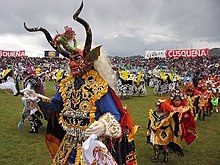| Revision as of 14:16, 3 August 2009 editMarshalN20 (talk | contribs)Extended confirmed users, Pending changes reviewers, Rollbackers15,094 editsNo edit summary← Previous edit | Revision as of 05:56, 5 August 2009 edit undo190.233.88.119 (talk)No edit summaryNext edit → | ||
| Line 4: | Line 4: | ||
| This mainly Andean theatrical reportoire that began during the Spanish colonization of South America in order to teach the local natives the precepts of Christian faith and history of the Spanish Empire. The diablada causes a reform in the thinking of the indigenous altiplano cultures as missionaries from Spain, instilled the paradigm of good and evil, which is how the costumes of angels and demons became associated with the dance. | This mainly Andean theatrical reportoire that began during the Spanish colonization of South America in order to teach the local natives the precepts of Christian faith and history of the Spanish Empire. The diablada causes a reform in the thinking of the indigenous altiplano cultures as missionaries from Spain, instilled the paradigm of good and evil, which is how the costumes of angels and demons became associated with the dance. | ||
| On XVI century, the jesuits, start "autos sacramentales", a dramatic representation of the mystery of the Eucharist in ] - ], thats why this city was call "little Rome of America" or "Aymaras Rome". Until XVI century, Puno was part of the viceroyalty of Río de la Plata and then of the viceroyalty of Perú. During the evangelism of the lupacas who used to live in Juli, the jesuits made a representation of the seven deadly sins, with the angel winning. | |||
| ==See Also== | ==See Also== | ||
Revision as of 05:56, 5 August 2009


The Diablada is a dance, with auto sacramental origins in Spain that is practised in various regions of the Andes specially the Altiplano (Bolivia, southeastern Perú, and nortern Chile). However, the dance is also practiced in Venezuela and Ecuador.
This mainly Andean theatrical reportoire that began during the Spanish colonization of South America in order to teach the local natives the precepts of Christian faith and history of the Spanish Empire. The diablada causes a reform in the thinking of the indigenous altiplano cultures as missionaries from Spain, instilled the paradigm of good and evil, which is how the costumes of angels and demons became associated with the dance.
On XVI century, the jesuits, start "autos sacramentales", a dramatic representation of the mystery of the Eucharist in Juli - Puno, thats why this city was call "little Rome of America" or "Aymaras Rome". Until XVI century, Puno was part of the viceroyalty of Río de la Plata and then of the viceroyalty of Perú. During the evangelism of the lupacas who used to live in Juli, the jesuits made a representation of the seven deadly sins, with the angel winning.
See Also
This dance-related article is a stub. You can help Misplaced Pages by expanding it. |